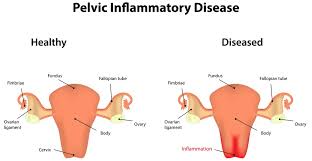How to Treat Acute and Chronic PID Respectively?
The pathogens causing PID (pelvic inflammatory disease) are Staphylococcus, Escherichia coli, Streptococcus, anaerobic bacteria and sexually transmitted pathogens such as gonorrhea, herpes virus, Chlamydia trachomatis, and mycoplasma. It is a common gynecological disease, inflammation can be limited to one part, or several parts at the same time. They are acute and chronic pelvic inflammation.
Symptoms:
1. Acute pelvic inflammation: There is a history of acute infection, lower abdominal pain, muscle tension, tenderness, and rebound pain, accompanied by rapid heart rate, fever, vaginal purulent secretions. Severe conditions may include high fever, headache, chills, loss of appetite, a large number of yellow and white discharge, abdominal distention, lumbar soreness, and so on; nausea, vomiting, or diarrhea, etc.

When peritonitis occurs and abscess forms, there may be lower abdominal mass and local compression irritation symptoms, the mass can lead to dysuria, frequent urination, urinary pain and so on and may locate in the back to cause abdominal pain, difficulty to defecate and feeling heavy after diarrhea.
2. Chronic pelvic inflammation: systemic symptoms are low fever sometimes and susceptible to fatigue. Some patients suffer from neurasthenia due to the long course of a disease, such as insomnia, depression, general discomfort, etc. Lower abdominal swelling, pain and lumbosacral pain, often get worse after fatigue, sexual intercourse, and menstruation. Because of chronic inflammation, pelvic blood stasis and excessive menstruation will occur.
Menstrual disorders will occur when ovarian function is damaged. Infertility will occur when there is a tubal-adhesion blockage. Acute inflammation may lead to diffuse peritonitis, sepsis and septic shock, and other serious consequences; chronic inflammation, due to long-term treatment and recurrence, will affect women's normal work and life as well as physical and mental health.
Diagnosis:

1. Acute pelvic inflammation: gynecological examination - vaginal congestion, posterior fornix tenderness, uterine congestion, edema, tenderness obvious. The uterus is slightly enlarged with tenderness and limited movement. Both appendages have tenderness, which can be touched or thicken on the mass, and fluctuate when the mass is formed.
2. Chronic pelvic inflammation: gynecological examination - the uterus is often posterior, with limited movement or adherence. Attachments can be seen in the following cases: salpingitis, hydro salpingitis or oviduct ovarian cyst, and pelvic nodal tissue inflammation.
Treatment:
The treatment of pelvic inflammatory disease mainly includes bed rest, nutrition supplementation and antibiotics (including broad-spectrum antibiotics and antianaerobic drugs), however herbal medicine can play a very special role as radical cure without side effects, such as Fuyan Pill. The raw medicinal material of this TCM formula are bupleurum chinense, poria cocos, scutellaria baicalensis, gardenia, etc. The prescription is the result of 30 years of clinical practice. Fuyan Pill improves the ancient prescription to make it more complete and fit for modern needs.

Acute pelvic inflammation can be treated with general supportive therapy, antibiotic therapy, external medication, and surgery; chronic pelvic inflammation can be treated with physical therapy, external medication, and surgery.
Prevention:
1. Pay attention to hygiene during menstruation, pregnancy, childbirth, and puerperium.
2. Pre-operative preparation for gynecological surgery. Attention should be paid to keeping the vulva clean and avoiding sexual intercourse three days before operation; the vulva should be washed daily with warm water; the perineal mat and underwear should be changed in time; sexual intercourse should be prohibited within 2 to 3 weeks.
3. Cure acute pelvic inflammation thoroughly and prevent it from becoming chronic. The pain of pelvic inflammation can make a woman as dull as a flower that loses its luster in those days of each month. When the pain in the lower abdomen is serious, we can not even carry out normal work and study. It is very important to find out early and treat it in time.
Natural Therapy For Gynecologic Inflammation
previous pageWho Are More Likely to Get PID: The White Collar Group?
next page
You may also be interested in
- Daily Care Tips for Pelvic Inflammatory Disease Caused by Ureaplasma Urealyticum
- Treatment of PID
- Why Does Pelvic Inflammatory Disease Cause Fatigue? Don't Ignore These 5 Symptoms!
- Can Abnormal Vaginal Discharge Cause Pelvic Inflammatory Disease?
- Can Pelvic Inflammatory Disease Cause Intestinal Symptoms?
Testimonials
- Adenomyosis with Ureaplasma Urealyticum Cured by Fuyan Pill
- Tubal blockage with hydrosalpinx can be cured by TCM shortly
- Fuyan Pill Helps A woman with Adenomyosis Get Pregnant
- A Woman with Hydrosalpinx Is Cured with Fuyan pill
- Pelvic Inflammatory Disease Testimonials
- Irregular Vaginal Bleeding and Endometrial Thickening Cured by Fuyan Pill
- Pruritus Vulvae and Frequent Urination: Mycoplasma Infection Cured after 2 Courses



